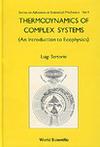复杂系统的热力学
1999-12
World Scientific Pub Co Inc
Sertorio, Luigi
208
Almost everything that happens around us are complex, non-linear,dissipative events. Fire, wind, the clouds, a jet of water, the crashing of a vase, an athletic performance; and within us, our memory. Non-dissipative, Hamiltonian events too are complex and non-linear. If there is one thing that is very difficult to understand, and little investigated, it is why Nature has simple laws that can be confirmed in simple cases and which can nearly always be dealt with linear differential equations. Nature organizes the masses of astronomical bodies in a prevalently spherical symmetry which allows a very simple calculation of the field of gravity, some-thing which is generally incalculable. The gravitational interactions, which are non-linear and intractable in cases of three bodies or more, are organised so that the multi-body problems are dominated by a prevailing mass that allows the perturbative method to be applied.
IntroductionAcknowledgments1. 1583; The harmonic oscillator.2. Irreversibility is not to be deduced.3. Equilibrium thermodynamics. Irreversibility and reversible processes.4. Equilibrium thermodynamics. Irreversibility and disequilibrium.5. From laboratory to environment.6. Expansion, large scale uniformity and local disequilibrium.7. Reversible, irreversible.8. Time scales.9. The cosmological engine.10. The equations of non-equilibrium thermodynamics. Rigid systems.11. The equations of non-equilibrium thermodynamics. Fluid systems.12. Active systems.13. Ecosystems.14. Ecosystem Earth and the radiation fluxes.15. Ecosystem Earth and its constitution .16. A model for the evaluation of Earth's availability.17. Comments on section 16.18. Interacting with the ecosystem. Global warming.19. Control and information.20. Brief sketch of one-directional control systems.21. Remarks on global control systems.22. Geophysical inputs.23. Thermodynamics of the inert house.24. Variable structure and online automaton Z(4,3).25. Thermodynamic demon and Entropy.26. The intellectual house.27. Conclusions.
